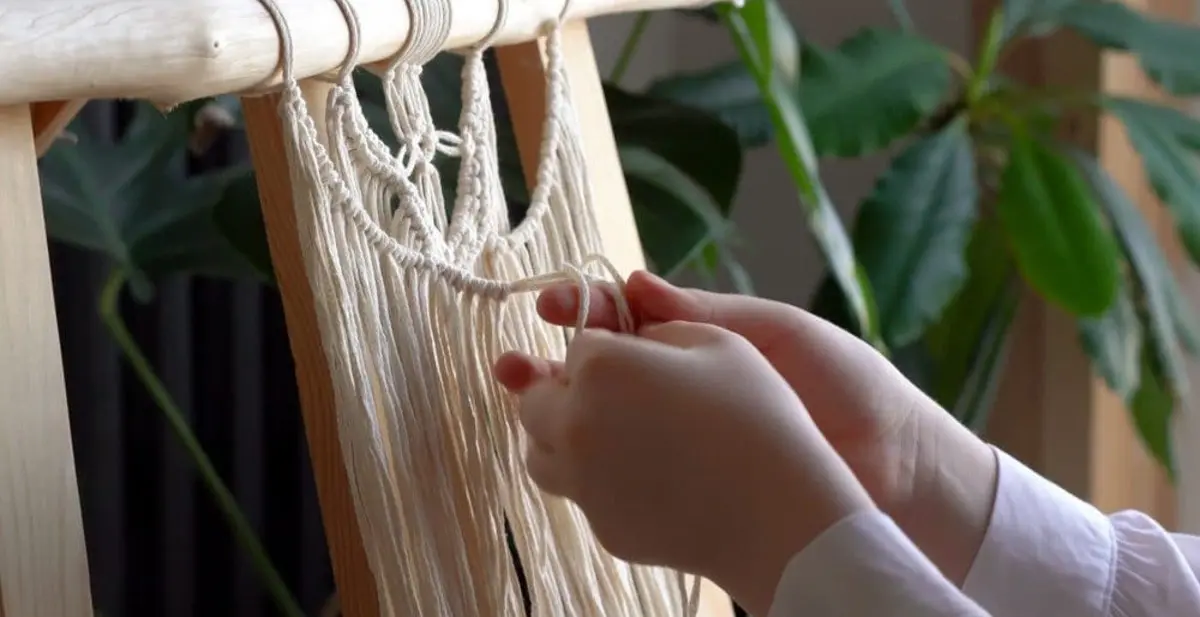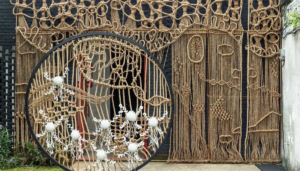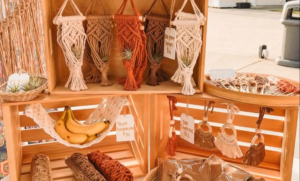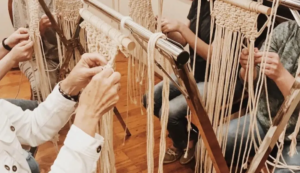Choosing the best cord for macrame beginners guide starts with understanding that your material selection determines everything from project durability to final appearance. Whether you’re dreaming of creating stunning wall hangings or functional plant holders, selecting the right cord transforms your macramé experience from frustrating struggle to creative joy.
Macramé has experienced an incredible renaissance, with Pinterest searches for macramé projects increasing by 4,000% over recent years. This ancient knotting technique, once reserved for sailors and textile artisans, now decorates modern homes worldwide. However, beginners often feel overwhelmed by the countless cord options available, leading to poor material choices that can make or break their first projects.
The journey to macramé mastery begins with one crucial decision: selecting the perfect cord. Your choice impacts knot clarity, project longevity, and overall crafting satisfaction. This comprehensive guide reveals the seven essential cord types every beginner should know, providing you with insider knowledge that typically takes months to discover through trial and error.
Understanding Macramé Cord Basics: Your Foundation for Success
The best cord for macrame beginners guide emphasizes understanding cord characteristics before making purchases. Macramé cords vary dramatically in texture, thickness, material composition, and intended use. Beginning crafters who skip this fundamental knowledge often waste money on unsuitable materials.
Natural fibers dominate the macramé world, offering superior knot-holding ability and aesthetic appeal. Cotton remains the most popular choice among beginners due to its forgiving nature and wide availability. Synthetic options provide specific advantages in outdoor applications or high-humidity environments.
Cord thickness, measured in millimeters or ply count, directly affects project scale and knot definition. Thicker cords create bold, statement pieces perfect for wall art, while thinner options suit delicate jewelry or small decorative items. Understanding this relationship helps beginners choose appropriately sized materials for their intended projects.
Twist direction and tightness influence how cords behave during knotting. Single-twist cords unravel easily, creating fringe effects, while tightly twisted varieties maintain their structure throughout complex knotting sequences. This characteristic becomes particularly important when creating projects requiring consistent tension.
Cotton Cord: The Beginner’s Best Friend
Cotton cord represents the gold standard for macramé beginners, offering an ideal balance of workability, affordability, and versatility. This natural fiber provides excellent grip during knotting, preventing slippage that frustrates newcomers. Cotton’s forgiving nature allows easy knot adjustments, enabling beginners to perfect their technique without material constraints.
Three-ply cotton cord, typically ranging from 3mm to 5mm thickness, suits most beginner projects perfectly. This configuration provides sufficient bulk for visible knots while remaining manageable for inexperienced hands. The individual plies separate cleanly for fringe creation, adding textural interest to completed projects.
Mercerized cotton offers enhanced durability and luster compared to standard cotton varieties. The mercerization process strengthens fibers and improves dye retention, resulting in vibrant, long-lasting colors. While slightly more expensive, mercerized cotton justifies its cost through superior performance and appearance.
Organic cotton appeals to environmentally conscious crafters, providing peace of mind alongside excellent working properties. These sustainable options often feature superior softness and reduced chemical processing, making them ideal for items requiring frequent handling or skin contact.
Macramé Rope vs. Cord: Clearing the Confusion
The best cord for macrame beginners guide must address the common confusion between rope and cord terminology. While often used interchangeably, these terms describe different product categories with distinct characteristics and applications.
Macramé cord typically measures 6mm or thinner, making it suitable for detailed work and intricate patterns. This category includes cotton cord, hemp twine, and synthetic alternatives. Cord flexibility allows for tight knots and complex weaving techniques essential in advanced macramé work.
Rope generally exceeds 6mm thickness, creating bold, architectural projects with dramatic visual impact. Macramé rope works beautifully for large wall hangings, plant hangers designed for heavy pots, and outdoor installations requiring weather resistance.
Single-strand rope offers different working properties than multi-ply alternatives. Twisted rope provides texture and visual interest but can be challenging for beginners to control. Braided rope maintains consistent thickness and proves easier to manage during complex knotting sequences.
Understanding these distinctions helps beginners select appropriate materials for their skill level and project requirements. Starting with medium-thickness cord (3-4mm) provides an excellent foundation for developing fundamental techniques.
Hemp: The Sustainable Choice with Character
Hemp cord brings unique characteristics to macramé projects, offering sustainability credentials alongside distinctive texture and appearance. This natural fiber provides excellent durability, making it ideal for functional items like bags, plant hangers, and outdoor decorations.
Natural hemp possesses a rustic, organic appearance that complements bohemian and natural design aesthetics. The fiber’s inherent strength supports heavy loads without stretching or breaking, making it perfect for structural macramé applications.
Hemp’s texture requires adjustment for beginners accustomed to smooth cotton cord. The slightly rough surface provides excellent knot security but may feel uncomfortable during extended crafting sessions. Wearing thin crafting gloves can alleviate this concern while maintaining knot control.
Bleached hemp offers a lighter color palette while retaining the fiber’s structural advantages. These processed versions often feel softer than natural hemp, providing easier handling for sensitive hands. However, chemical processing may reduce some of hemp’s environmental benefits.
Synthetic Options: When Durability Matters Most
Synthetic cords serve specific applications where natural fibers fall short, particularly in outdoor or high-moisture environments. The best cord for macrame beginners guide includes these options for crafters planning weather-exposed projects.
Polyester macramé cord resists fading, moisture damage, and mold growth, making it ideal for patio decorations and garden installations. The fiber’s consistent thickness and color retention ensure projects maintain their appearance through multiple seasons.
Nylon cord offers exceptional strength-to-weight ratios, supporting heavy loads while remaining relatively thin. This characteristic proves valuable for functional items requiring both durability and refined appearance. However, nylon’s slippery surface can challenge beginners learning knot techniques.
Polypropylene provides budget-friendly synthetic options with adequate performance for practice projects. While lacking the aesthetic appeal of natural fibers, polypropylene allows beginners to experiment with techniques without significant material investment.
Synthetic blends combine natural and artificial fibers, attempting to capture benefits from both categories. Cotton-polyester blends offer improved durability while maintaining much of cotton’s workability and appearance.
Thickness Guide: Matching Cord Size to Your Vision
Selecting appropriate cord thickness represents a crucial decision in the best cord for macrame beginners guide. Thickness directly impacts knot visibility, project scale, and overall aesthetic appeal. Understanding these relationships helps beginners choose confidently.
Ultra-thin cords (1-2mm) suit jewelry making and delicate decorative items. These sizes require precise technique and often prove challenging for absolute beginners. However, they create elegant, refined pieces when mastered.
Medium thickness cords (3-4mm) provide the sweet spot for most beginner projects. This range offers excellent knot definition while remaining manageable during learning phases. Wall hangings, small plant hangers, and table runners work beautifully in these sizes.
Thick cords (5-8mm) create bold, statement pieces with dramatic visual impact. These sizes work well for large wall art, substantial plant hangers, and architectural installations. Beginners may find thick cords easier to handle due to their substantial feel.
Extra-thick options (9mm and above) enter rope territory, requiring different techniques and tools. While impressive in final form, these sizes can overwhelm beginners with their bulk and weight.
Color Considerations: Beyond Basic Beige
Color selection significantly impacts project success, with the best cord for macrame beginners guide emphasizing both aesthetic and practical considerations. While natural tones dominate traditional macramé, modern crafters embrace diverse color palettes.
Natural, undyed fibers showcase knot structure most clearly, making them ideal for learning fundamental techniques. Beige, cream, and light brown tones highlight pattern details while maintaining timeless appeal. These colors also photograph well for social media sharing.
Earth tones including sage green, terracotta, and dusty rose reflect current interior design trends while maintaining macramé’s natural aesthetic. These colors complement modern home décor while avoiding overwhelming boldness that might date quickly.
Bold colors make striking statements but require careful consideration of placement and surrounding décor. Deep jewel tones, vibrant blues, and rich purples create dramatic focal points but may limit project versatility.
Variegated or ombré cords provide color interest without requiring multiple material purchases. These options create subtle gradations that add visual depth while maintaining project cohesion.
Essential Tools and Preparation Techniques
The best cord for macrame beginners guide includes proper preparation techniques that dramatically impact project success. Professional results depend not only on cord selection but also on proper setup and tool usage.
Sharp fabric scissors prove essential for clean cuts that prevent fraying. Dedicated macramé scissors with pointed tips enable precise trimming in tight spaces. Investing in quality cutting tools prevents frustration and improves finished project appearance.
Measuring techniques ensure adequate cord length while minimizing waste. The general rule suggests cutting cords four times the desired finished length, but complex patterns may require more material. Beginning with extra length prevents mid-project shortages.
Cord preparation includes gentle combing or brushing to remove loose fibers and ensure consistent texture. This step proves particularly important with natural fibers prone to shedding. Clean cords create neater knots and more professional results.
Work surface selection affects project comfort and quality. Firm, smooth surfaces prevent cord snagging while providing adequate support for tensioning knots. Macramé boards with measurement guides help maintain consistent spacing and alignment.
Project-Specific Cord Recommendations
Different macramé projects benefit from specific cord characteristics, with the best cord for macrame beginners guide providing targeted recommendations for common beginner projects.
Wall hangings showcase knot patterns most effectively with medium-thickness cotton cord (3-4mm). This size provides excellent definition while remaining manageable for complex patterns. Natural or off-white colors highlight texture without overwhelming room décor.
Plant hangers require strength above aesthetic considerations, making hemp or thick cotton cord (4-6mm) ideal choices. These materials support plant weight reliably while maintaining attractive appearance. Consider natural colors that complement plant foliage.
Jewelry projects demand thin, flexible cords that drape naturally and feel comfortable against skin. Fine cotton or hemp (1-2mm) works beautifully for bracelets, necklaces, and earrings. Ensure materials are skin-safe and colorfast.
Table runners and placemats benefit from flat, consistent cords that lie smoothly. Medium cotton cord or ribbon-style materials create elegant results while providing adequate durability for functional use.
Budget-Friendly Options for Beginners
Starting macramé doesn’t require significant investment, with the best cord for macrame beginners guide emphasizing affordable options that don’t compromise quality. Smart shopping strategies help beginners explore the craft without financial stress.
Cotton twine from hardware stores often provides excellent value for practice projects. While not specifically marketed for crafts, quality cotton twine works beautifully for learning basic knots and techniques. Always verify material composition before purchasing.
Buying in bulk reduces per-unit costs significantly when planning multiple projects. Joining with crafting friends or local groups enables bulk purchasing while sharing costs and materials. This strategy proves particularly effective for expensive specialty cords.
Natural cotton cord offers the best balance of affordability, workability, and appearance for most beginners. Avoiding specialty brands or exotic materials during learning phases prevents unnecessary expense while building fundamental skills.
Seasonal sales at craft stores provide opportunities for significant savings on quality materials. Stocking up during promotional periods ensures adequate supplies for extended crafting sessions while respecting budget constraints.
Common Beginner Mistakes to Avoid
The best cord for macrame beginners guide highlights frequent errors that derail beginner projects. Understanding these pitfalls helps newcomers avoid frustration and achieve better results faster.
Purchasing inadequate quantities ranks among the most common mistakes. Running short mid-project forces compromises or complete restarts. Always buy 20% more cord than calculated needs to account for learning curve and potential errors.
Choosing inappropriate thickness for skill level frustrates many beginners. Ultra-thin cords prove difficult to handle, while extremely thick options can overwhelm small hands. Starting with medium sizes (3-4mm) provides optimal learning experiences.
Mixing incompatible materials within single projects creates inconsistent results. Different fibers behave differently during knotting, leading to tension irregularities and poor appearance. Stick with single material types until gaining experience.
Ignoring twist direction causes unnecessary complications during complex patterns. Understanding cord construction helps predict behavior and prevents mid-project surprises. Always test small sections before committing to full projects.
Advanced Techniques: Growing Your Skills
As skills develop, the best cord for macrame beginners guide encourages exploration of advanced materials and techniques. Progressive challenges maintain interest while building expertise systematically.
Experimenting with mixed materials creates unique textures and visual interest. Combining cotton with hemp or incorporating ribbon accents adds sophistication to basic patterns. Start with small test pieces before attempting major projects.
Learning cord preparation techniques like singeing and sealing prevents fraying while creating professional finishes. These skills prove particularly valuable when working with synthetic materials or creating items requiring frequent handling.
Understanding fiber properties enables informed material selection for specific applications. Knowledge of strength, elasticity, and weather resistance guides choices for challenging projects or unusual environments.
Developing personal style through consistent material choices creates cohesive body of work. Many successful macramé artists become known for signature material combinations or color palettes that distinguish their pieces.

Macrame Wall Hanging Handwoven Bohemian Cotton
Add a touch of bohemian elegance to your interiors with our Handwoven Macrame Wall Hanging. This stunning piece of fiber art not only showcases a unique exotic style but also reflects the free-spirited personality of bohemian aesthetics.
Frequently Asked Questions
What thickness cord should complete beginners start with for their first macramé project?
Most experts recommend 3-4mm cotton cord for absolute beginners. This thickness provides excellent knot visibility for learning while remaining easy to handle. The size works perfectly for popular beginner projects like wall hangings and simple plant hangers, offering enough substance to create satisfying results without overwhelming inexperienced hands.
Can you use regular rope from hardware stores for macramé projects?
Hardware store rope can work for practice projects, but quality varies significantly. Always choose natural fiber options like cotton or hemp, avoiding synthetic ropes with chemical treatments that may cause skin irritation. While these alternatives cost less, they often lack the consistent thickness and smooth texture that make learning easier and results more professional.
How much cord do you typically need for a small beginner wall hanging project?
A small wall hanging (12-18 inches wide) typically requires 8-12 pieces of cord, each cut to 4-6 feet long. This accounts for the standard rule of cutting cord four times longer than your desired finished length. Always purchase extra material beyond your calculations, as beginners often need additional practice attempts and may make cutting errors.
What’s the difference between single-twist and three-ply macramé cord for beginners?
Three-ply cord consists of three separate strands twisted together, making it stronger and more stable for beginners. Single-twist cord tends to unravel more easily, which can be useful for creating fringe effects but proves challenging when learning basic knots. Three-ply cord maintains its structure better during the learning process, leading to neater results and less frustration for newcomers.
Conclusion
Mastering the best cord for macrame beginners guide transforms your crafting journey from overwhelming confusion to confident creativity. The seven essential cord types covered in this comprehensive guide provide the foundation for countless beautiful projects, whether you choose classic cotton for its beginner-friendly properties or sustainable hemp for its distinctive character.
Remember that your material selection directly influences project success, with thickness, texture, and fiber type each playing crucial roles in final results. Starting with quality 3-4mm cotton cord gives you the perfect foundation for developing fundamental skills while creating satisfying first projects.
As you progress in your macramé journey, experiment with different materials and thicknesses to discover your personal preferences and signature style. The investment in quality cord pays dividends through improved results, reduced frustration, and increased crafting satisfaction. Your next macramé masterpiece starts with choosing the right cord – use this guide to make that crucial first decision with confidence.









